 Research Article
Research Article
A Comparative Analysis on Changing of Different Properties of Greige Woven Fabric (3/1, 2/1 Twill) After Scouring & Bleaching and Mercerizing
Abu Naser Mohammed Sayem* and Sahabuddin Sagor
Department of Textile Engineering, BGMEA University of Fashion & Technology(BUFT), Bangladesh
Abu Naser Mohammed Sayem, Department of Textile Engineering, BGMEA University of Fashion & Technology(BUFT), Bangladesh.
Received Date: July 29, 2021; Published Date: September 09, 2021
Abstract
The aim of the project was to compare the change of different types of physical and chemical properties like tensile strength, tear strength, GSM, EPI, absorbency and Pʰ of greige woven fabric after the pretreatment processing. That will ease the process of product development, assume the properties of the final product, and minimize textile wastage.
The research included woven 2/1 and 3/1 twill fabric. Fabric samples were tested after every process except desizing. Gradual increase in EPI from greige to mercerizing of 11.75% and 20.75% in average respectively for 2/1 twill and 3/1 twill has been noted. The overall decrease in width from greige to mercerizing noted 13.09% and 16.93% respectively for 2/1 twill and 3/1 twill. GSM of the samples tended to increase after mercerizing than scouring and bleaching. Fabrics tend to have a Pʰ value around neutral after mercerizing and alkaline after scouring & bleaching. Absorbency of fabric decreases after mercerizing than scouring and bleaching. Tensile strength, Tear strength also have been tested for comparison.
Keywords:Woven fabric; Properties; Pretreatment; Scouring; Bleaching; Mercerizing; Tensile strength; Tearing strength; GSM; EPI; Absorbency
Introduction
One of the most common fabric manufacturing methods is the interlacing of yarns, which makes woven fabric. Woven fabric may be the most versatile and complex in design. By changing the pattern of interlacement, the design of woven fabric can be changed [1]. The warp and weft yarns having natural color and impurities of fibers in raw form exist in greige fabric. So, all the woven fabrics need to undergo some wet processing called Singeing & Desizing, Scouring & Bleaching, Mercerizing. All the fabrics must undergo these steps before dying or any processing. These processes have a remarkable influence on fabric properties [2].
Pretreatment processes were done in an export-oriented dying printing and finishing factory facility and the testing was done with standard types of machinery maintaining ISO standards. During these processes the fabric tends to have changes in its physical and chemical properties like EPI (Ends per Inch), GSM (Gram per Square Meter), width, Pʰ, absorbency, tensile strength, tear strength.s
Scouring and Bleaching are generally performed in a continuous machine. Scouring is mainly done for making the fabric more hydrophilic by removing the impurities like seed particles, wax, oil of fiber [3]. Then bleaching is done for removing the yellowish natural color of raw yarn making the fabric brighter and whiter. Treatment with mostly alkaline chemicals makes the fabric alkaline in nature in Pʰ after the scouring and bleaching process.
The mercerizing is mainly done to improve cotton fabric properties like smoothness, Tensile strength, dye affinity, and dimensional stability [4,5]. Fabrics are treated with NaOH (Sodium Hydroxide) and given a width-wise tension thus the fibers tend to be more crystalline in nature making the fabric more lustrous. After the treatment, the fabric undergoes an acid wash. Thus, the Pʰ of fabrics after the process most of the time gets neutral that is 6.5-7.5.
The tensile strength of fabric is the maximum force it can take per unit area before breaking. It varies with different terms such as yarn count, yarn density, and most importantly the design of the fabric [1]. There is an effect of wet processing in changing tensile strength of fabric.
The tearing strength of fabric is the force required to start or to continue a tear of fabric in both the warp and weft direction. Tearing can be described as the sequential breakage of yarns or groups of yarns along a line through a fabric. The tearing strength is often used to give a reasonably direct assessment of serviceability than the tensile strength and fabric with low tearing strength is generally an inferior product. In the case of tensile loading, all the yarns in the direction of loading share the load; in tear loading, only one, two, or at most a few yarns share the load. The tearing strength is affected by changes in yarn geometry, fabric geometry, relaxation of the fibers, and their frictional characteristics. The movement of the yarns will be restricted in tight constructions and results in a low tearing strength. Loose and open constructions allow yarns to move and group together, thus resulting in a higher tearing strength [6].
Materials and Methods
Fabric
All the twill fabric samples (3/1, 2/1) were collected from the facility of Unifill Dyeing Printing & Finishing Mills Ltd.
Scouring & bleaching
Benninger scouring and bleaching machine used with chemicals as per company procedure
Mercerizing
Goller mercerizing machine was used with chemicals were used as per company procedure.
Testing
All the testing was done in the OEKO-TEX certified testing lab of Unifill Dyeing Printing & Finishing Mills Ltd.
Width
Width was measured by measuring tape from selvedge to selvedge of fabric with precision after each processing.
EPI
Counting glass used for counting the EPI of fabric after every process.
GSM
Standard GSM cutter following ISO-3801:1977 and digital weighing scale of 4 digits used to measure the GSM after each process.
Absorbency
A solution of 200 ml of reactive dye made in a beaker. A fabric sample cut on a size of 15cm×1cm in the warp direction. Five sections of 1cm marked with a pencil or pen. Each section counted as 1 for absorbency. The fabric strip is hung on a stick with glue at a 10cm distance. The very first section of the strip needs to be fully immersed.
Pʰ
Universal Pʰ indicator was used for testing the Pʰ of fabric for our work. One drop of the solution applied to the surface of fabric. The color of the outer edge of the drop was cross-matched with the color of the Pʰ meter.
Tear strength
Elma-tear Tear Testing machine was used for this test following ISO-13937-1-2000. Fabric specimen cut in a size of 10cm×6.3cm both in warp and weft direction. One at a time tested for tear strength.
Tensile strength
TITAN-5 Universal strength tester used for this test following ISO-13934-2-1999. Fabric specimen cut in a size of 10cm*20cm both in warp and weft direction for measuring warp and weft tensile strength respectively.
Results and Discussions
Tensile strength
As shown in Table 1 Figure 1, 5 out of 7 of 2/1 twill fabric samples showed a noticeable increase in tensile strength in the warp direction after mercerizing than from scouring and bleaching except sample no. 2 and 3. In the weft direction for 5 out of 7 fabric samples increased strength after mercerization than scouring & bleaching has been noticed. we can say fabrics have a greater tensile strength in the greige stage.
Table 1:Characteristic of the patients with AED withdrawal (n=162).
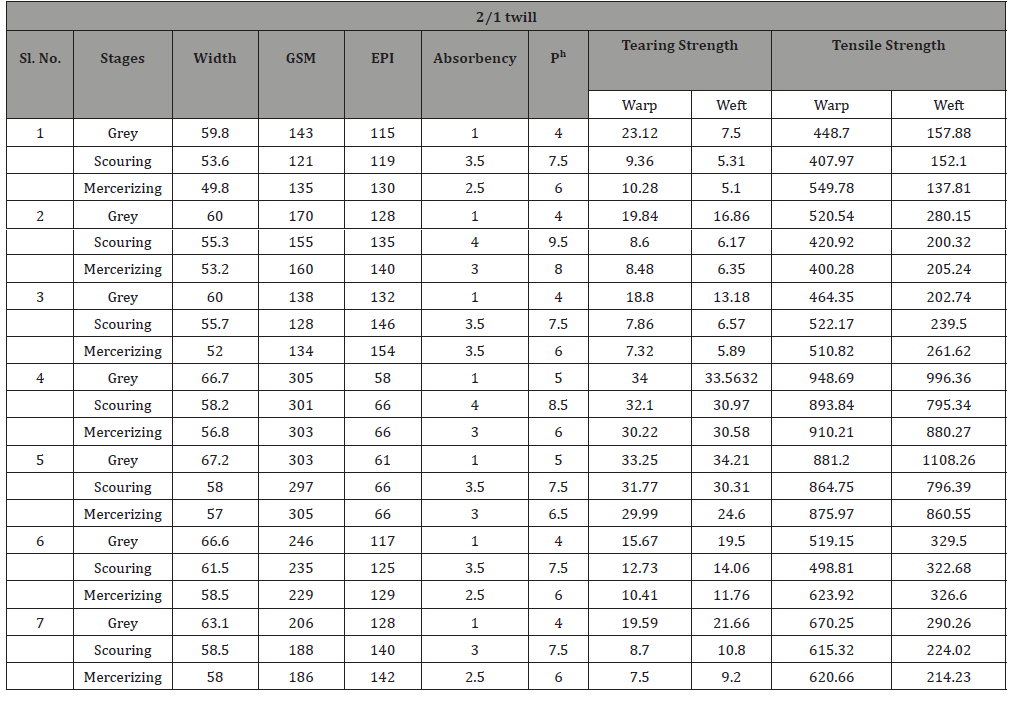
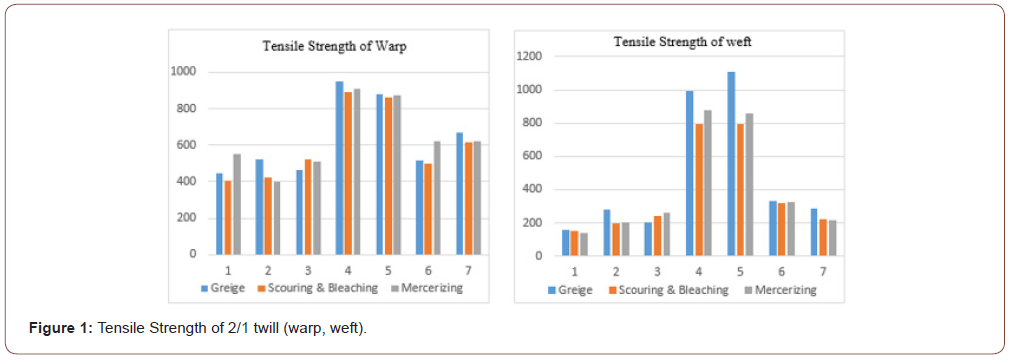
Tear strength
From Table 1, Figure 2, we can see without an exception of sample no. 01 all the fabric samples of 2/1 twill tend to decrease gradually in tearing strength after each processing in both warp and weft way.
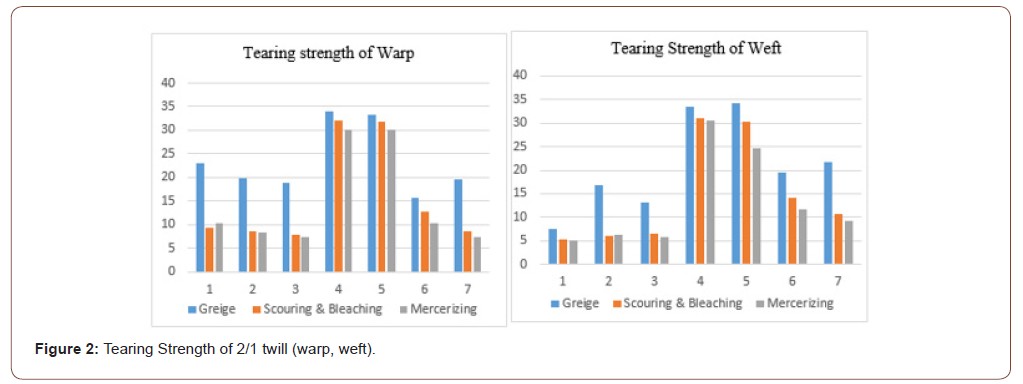
Absorbency
From Table1, Figure 3, The absorbency of fabric in the greige stage is null. Fabric does not absorb any chemical in the greige form before desizing, as the test is done by emerging the sample in 1cm dye solution, absorbency assumed as 1. The absorbency of fabrics tends to be greater after scouring and bleaching that is 3-4. Most of the fabric samples showed an absorbency level of 3.5 after scouring & bleaching. Most of the fabric showed a decreased absorbency of 2.5-3 after mercerizing.
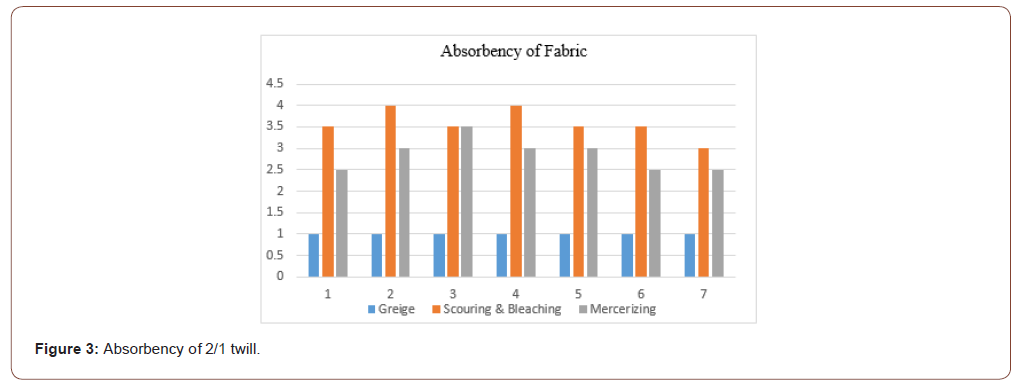
pH
From Table-I Figure 4, The Pʰ of fabric in the greige stage is acidic. All the fabric samples showed a value between 4-5. After treating with chemicals during scouring & bleaching, fabric samples tend to be slightly alkaline in nature. In our experiment, we get all values between 7.5-9.5. After the mercerization process, fabric comes in neutral nature 6 in most of the samples.
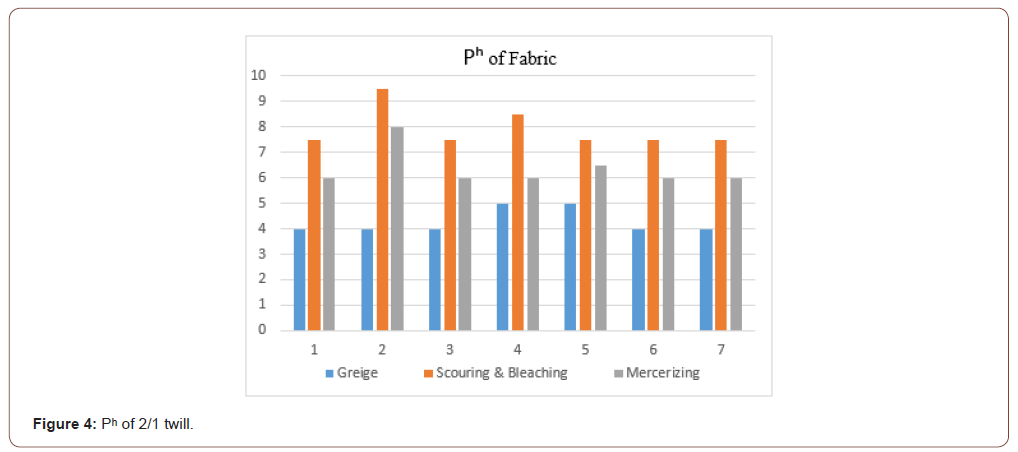
EPI
From Table1, Figure 5, EPI of all the fabric increased gradually after all the processing. EPI of all the fabric increase throughout the process to a great extent. The lowest count of EPI was found in the greige stage. After scouring & bleaching, the EPI increased 7.52% and increased 3.96% after mercerizing on average. We got an overall 11.75% increase in EPI from greige to mercerizing. The lowest increase in EPI was 8.20%, and the highest was 16.67%.
Width
From Table 1, Figure 6, A gradual decrease in the width of samples recorded during the experiment. 9.54% decrease after scouring & bleaching and 3.91% decrease after mercerizing noted. An overall decrease from greige to mercerizing of 13.09% was seen. The highest decrease was seen in sample no. 1. That is 16.72%, and the lowest decrease was 8.08%.
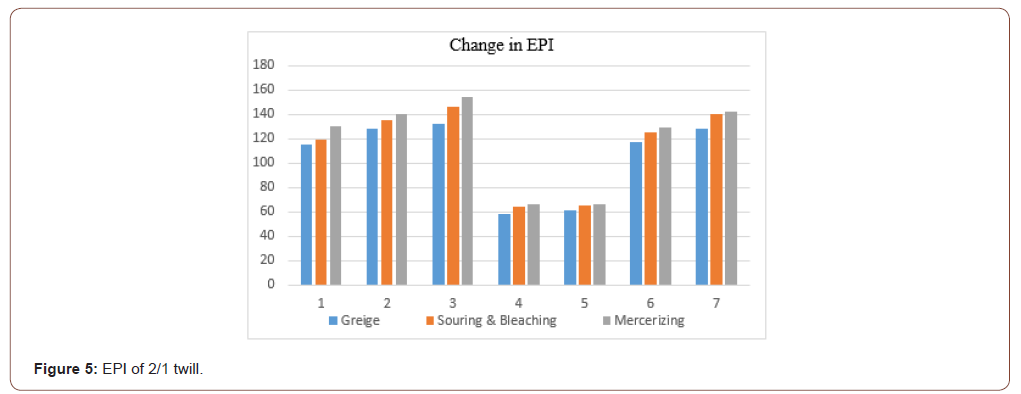
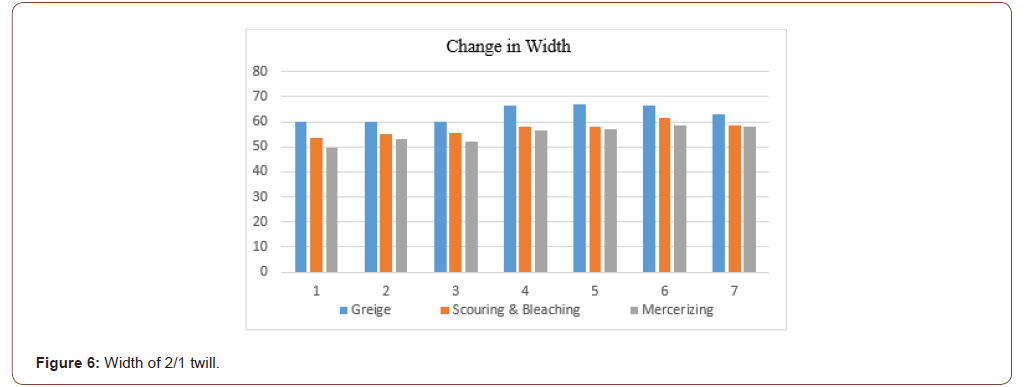
GSM
From Table 1, Figure 7, GSM of all samples showed an almost similar pattern in the line chart. The GSM of fabric decreases after scouring and bleaching and then increases further after mercerizing. The GSM decreases about 6.85% after scouring and bleaching and increases 4.04% after mercerizing than scoured and bleached fabric on average. The average decrease in GSM from greige to mercerizing was noted at 3.22%.
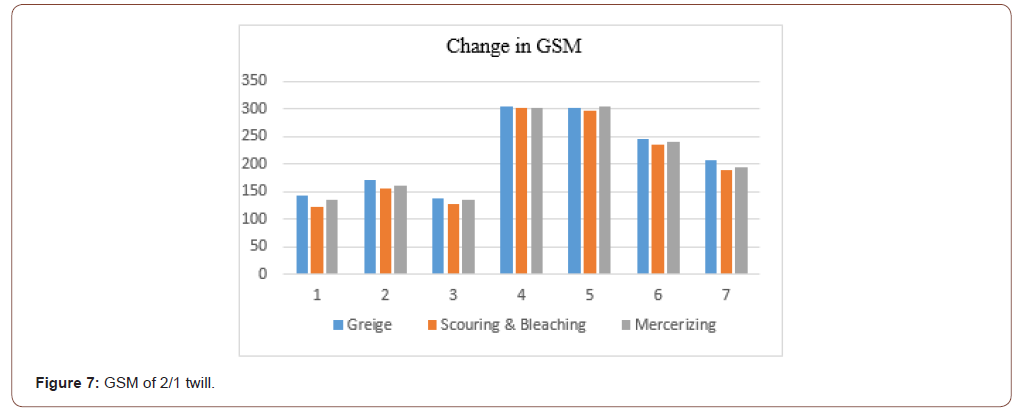
Tensile strength
From Table 2, Figure 8, No regular trend was seen for tensile strength of both warp and weft direction on 3/1 twill fabrics. Only 5 of the 10 samples showed increased and highest tensile strength after mercerization than other stages in the warp direction.

Table 2:3/1 Twill fabric properties after different stages.
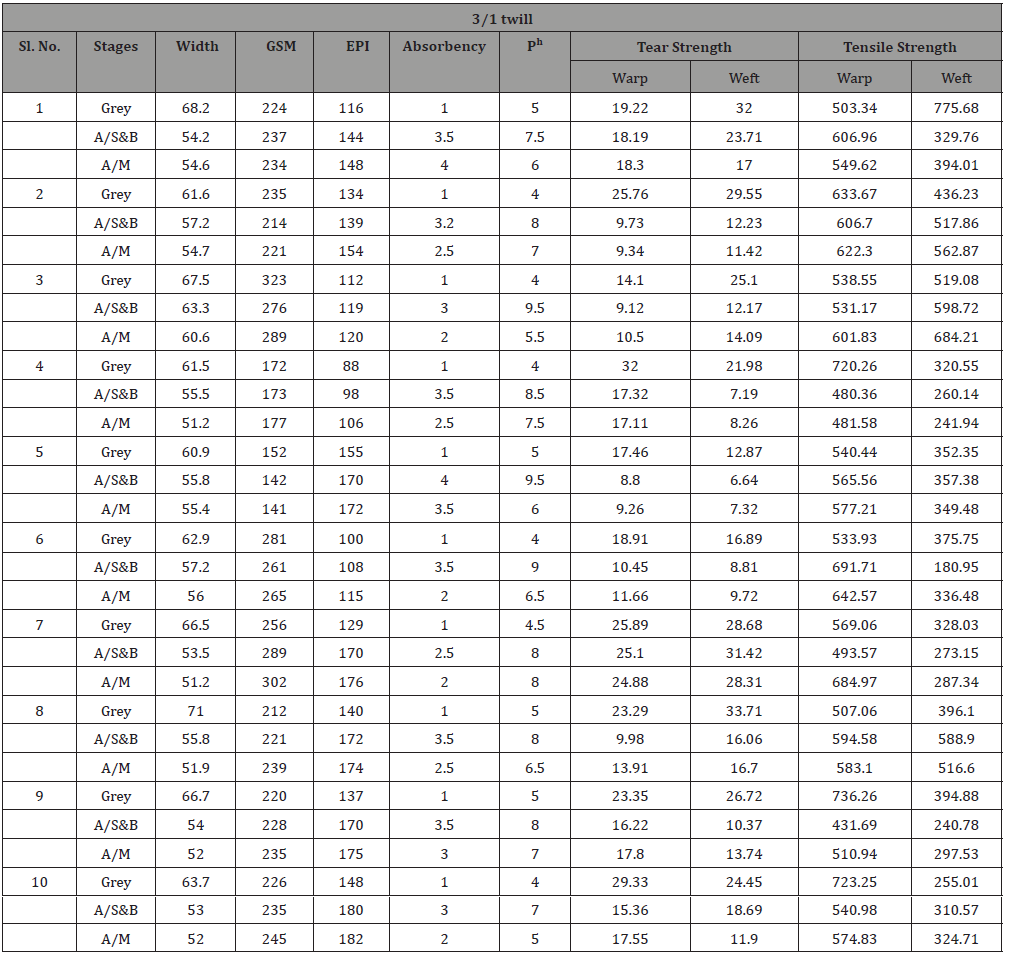
No regular tendency has been seen at the weft direction also, but most of the sample’s tensile strength at the mercerization stage was greater than the scouring & bleaching stage.
Tearing strength
From Table 2, Figure 9, All the samples have the most tearing strength value at the greige stage. 7 fabric samples out of 10 showed an increased value of tear strength after mercerizing than scouring and bleaching in warp way and 6 of 10 in the weft direction.
Absorbency
From Table 2, Figure 10, Most of the fabrics showed greater absorbency after scouring & bleaching than other stages. Most of the fabric samples had an absorbency level of 3-3.5 without two exceptions. After mercerization, the value decreases to 2-2.5 for most of the cases.
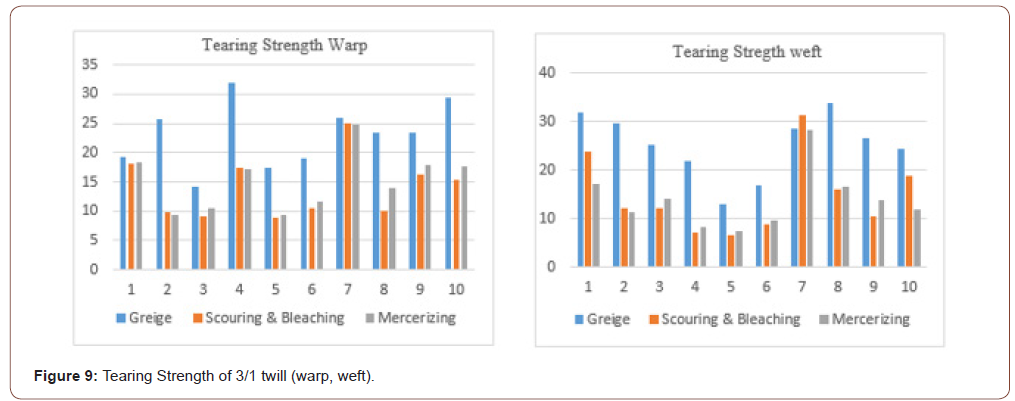
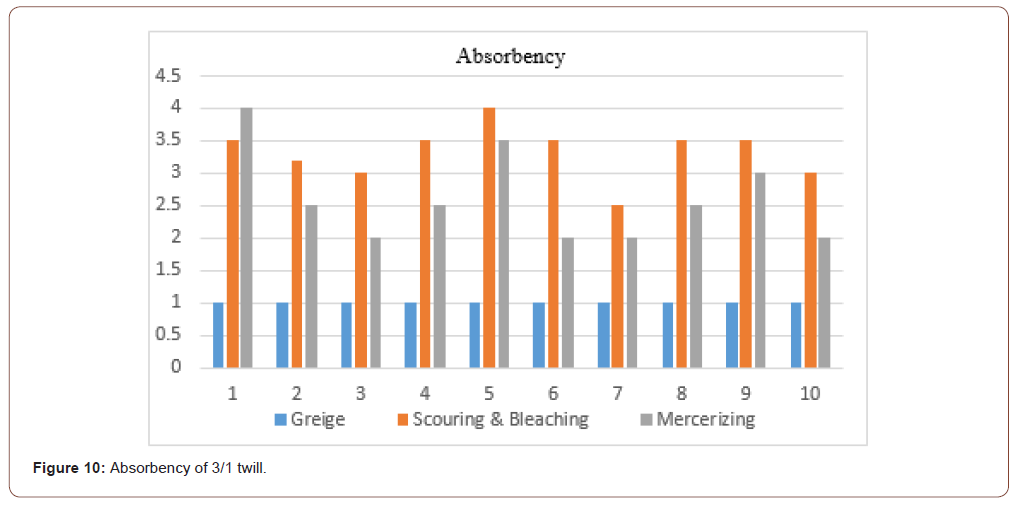
Pʰ
From Table 2, Figure 11, The 1.1. Pʰ of fabric in the greige stage is acidic. All the fabric samples showed a value between 4-5. After treating with chemicals during scouring & bleaching, the fabric samples tend to be slightly alkaline in nature. In our experiment, most of the fabric showed a value of 7-8, some of them showed 8.5- 9.5 after scouring and bleaching. After the mercerization process, fabric samples tend to be neutral in nature, 6-7.5 in most of the fabric samples.
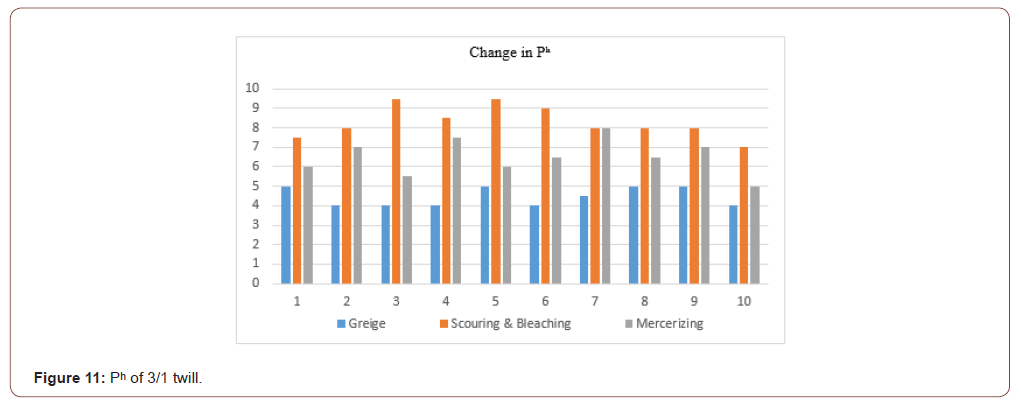
EPI
From Table 2, Figure 12, EPI of all the fabric increased gradually after all the processing. The lowest count of EPI is found in the greige stage. After scouring & bleaching, the EPI increased 16.35% and increased 3.90% after mercerizing on average. We got an overall 20.75% increase in EPI from greige to mercerizing. The lowest EPI increase is 7.14%, and the highest 36.43% from greige to the mercerizing stage.
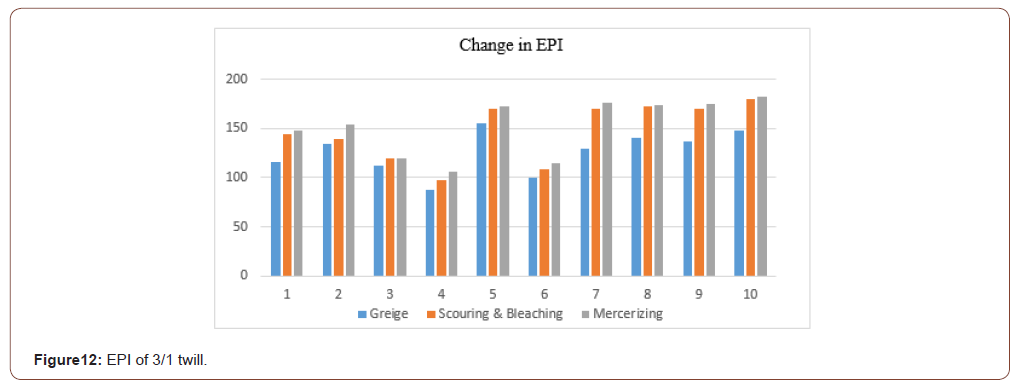
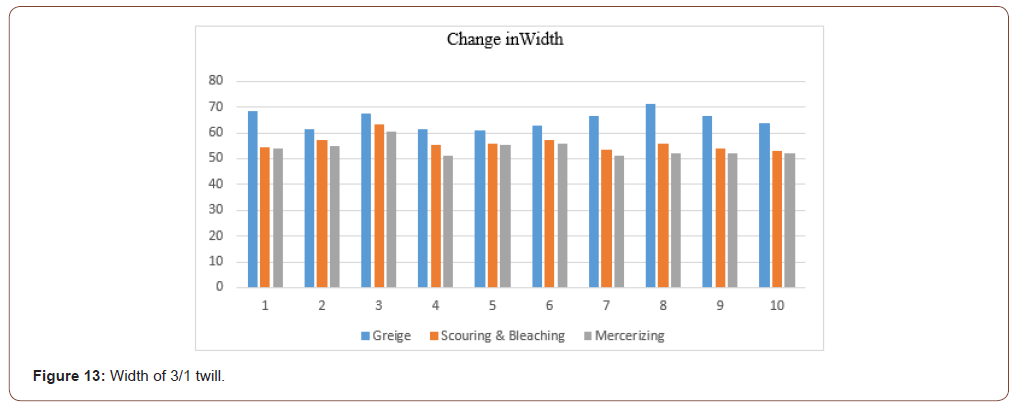
Width
From Table 2, Figure 13, A gradual decrease in the width of all samples is seen during the experiment. We got a 13.79% decrease after scouring & bleaching and a 3.64% decrease after mercerizing. We got an overall decrease from greige to mercerizing of 16.93%. The lowest decrease in width was 9.03%, and the highest was 26.90%.
GSM
From Table 2, Figure 14, As EPI increases, and width decreases the yarns tend to come closer to each other. That is the reason behind increased GSM of fabric samples. The samples having less decrease in width and EPI have less increase in GSM. Some of the fabric also tend to have a less GSM after mercerizing than greige stage. The highest decrease was recorded 10.53% and Highest increase of 17.57% was also recorded from greige stage to mercerizing.
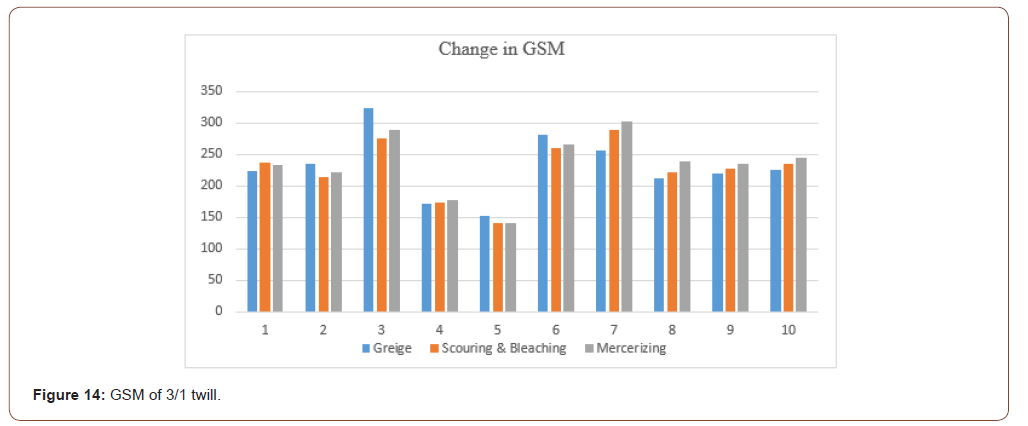
Conclusions
The findings from the experiment can help on planning of product development. How the properties tend to change after the processing and how they will behave on the next processing step. Every property of a fabric depends on another and these properties affect the end use of the fabric. 3/1 and 2/1 twill fabric samples showed a different type of behavior because of difference in their build structure. Tensile strength and tearing strength of the samples showed completely different values and varied fabric to fabric. Absorbency and pH values of fabric samples were pretty similar. Due to swelling of yarn most of the fabric samples showed an increased number of EPI after each stage and decrease in width.
Acknowledgement
Thanks to Mr. Md. Kamal Uddin Ahmed ED, Unifilltex Group Ltd. for giving the opportunity for the testing of samples.
Conflict of Interest
Authors declare no conflict of interest.
References
- Hari BK (2010) Woven textile structure Theory and applications. Woodhead Publishing Limited, Sawston, United Kingdom.
- Nassif NA (2019) Effect of different wet processing stages on physical properties of cotton woven fabrics. Fibres and Textiles 4: 13-18.
- Teli MD, Adere TT (2016) Short and efficient desizing and scouring process of cotton textile materials. International Journal of Engineering Trends and Technology 36(6): 256-269.
- Wakida T, Lee M, Park SJ, Saito M (2002) Effect of hot mercerization on liquid ammonia treated cottons. Fiber 58(5): 185-187.
- Kim SI, Lee ES, Yoon HS (2006) Mercerization in degassed sodium hydroxide solution. Fibers and Polymers 7(2): 186-190.
- Eryuruk SA, Kalaoğlu F (2015) The effect of weave construction on tear strength of woven fabrics. AUTEX Research Journal 15(3): 207-214.
-
Abu Naser Mohammed Sayem, Sahabuddin Sagor. A Comparative Analysis on Changing of Different Properties of Greige Woven Fabric (3/1, 2/1 Twill) After Scouring & Bleaching and Mercerizing. J Textile Sci & Fashion Tech 9(2): 2021. JTSFT. MS.ID.000706.
-
Woven fabric, Properties, Pretreatment, Scouring, Bleaching, Mercerizing, Tensile strength, Tearing strength, GSM, EPI, Absorbency
-

This work is licensed under a Creative Commons Attribution-NonCommercial 4.0 International License.






